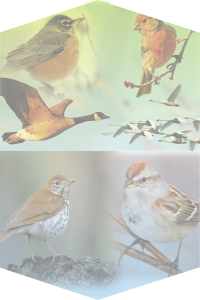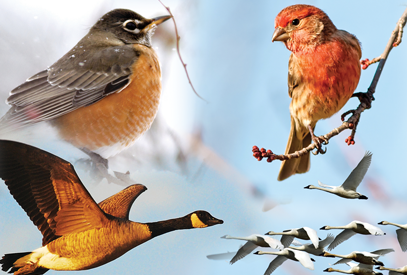Note: this is the full article by Guest Contributor MARK NEWSTROM. An excerpt of this article is featured in the March/April 2019 Bird’s-Eye View Newsletter
Since the beginning of this author’s life in the mid-1950s, the variety of birds seen in and around the Twin Cities area has surprisingly changed. Herein are five examples of bird species that were not here then or were much less abundant. I will then give two examples of birds that are, sadly, harder to find
 American Robins
American Robins
Until the late 1980s, I regularly participated in National Audubon Society’s Christmas Bird Count. At that time, American Robins were an exciting “rarity”. These winter days, it is even more surprising to not have numerous robins somewhere in town. Among factors contributing to this change are warmer winters, greater availability of open water and the large number of planted fruit trees.
Red-bellied Woodpeckers
Red-bellied Woodpeckers became a firmly established breeding bird in the Twin Cities area around the mid-1950s. They were not seen at all at the family cabin near Brainerd until the early 1970s and were confirmed nesting in the mid-1980s. At least one study notes their use of bird feeders as a factor in their increasing northern presence.
House Finches
The House Finch, or “Hollywood Finch” of the 1930s, was illegally sold in the eastern United States as a cage bird. To quote the Minnesota Breeding Bird Atlas, “[a]lthough the evidence is circumstantial, it seemed that one or more local dealers released the birds to avoid prosecution.” These newly-freed birds were not expected to survive. Instead, the eastern House Finch population thrived and expanded westward. The first documented nesting in the Twin Cities was in 1989. Since 1992, House Finches have been seen in most of Minnesota.
Trumpeter Swans and Canada Geese
Trumpeter Swans and Canada Geese are quite common today. The latter considered by some people nearly a pest, especially should they defecate in areas well trafficked by humans. But both species were extirpated or nearly absent from the state, mostly from being sources of food and feathers.
Trumpeter Swans were gone from their traditional Minnesota breeding areas by the mid-1800s. Only a very concerted reintroduction effort by Three Rivers Park District (then Hennepin County Park Reserve District) has led to a small but steady and viable population. This effort was begun in 1966 and only ended in 2009.
Canada Geese were considered gone from the state, until a small population was discovered at Silver Lake in Rochester. From these approximately 4000 birds, intensive and very successful reintroduction efforts were begun in the mid-1960s. In only a decade, geese were again being seen nearly throughout Minnesota.
Veery
The Veery is a variety of thrush, slightly smaller than a robin, with mostly a light brownish head, back and tail,
and a whitish breast with smudgy light brown spots just below its head. It is known for its rich, downward spiral of song. In many parks around the Twin Cities area and in wet, wooded areas around Minnesota, the Veery would make its presence felt from mid-spring through mid-fall, migrating to Brazil in the winter. However, its song is becoming more scattered with the years, mostly due to loss of habitat and nest parasitism by Brownheaded Cowbirds.
American Tree Sparrow
The American Tree Sparrow was once a very abundant winter visitor. This feisty little sparrow was Jim Gilbert’s study species as he learned their habits and habitats in the early 1970s. However, a severe ice storm in the winter of 1983-84 decimated the population wintering in the Twin Cities area, and it is only since 2015 that this species has started to approximate its former numbers.
Which avian friends are giving you pause for thought nowadays?
House Finches
The House Finch, or “Hollywood Finch” of the 1930s, was illegally sold in the eastern United States as a cage bird. To quote the Minnesota Breeding Bird Atlas, “[a]lthough the evidence is circumstantial, it seemed that one or more local dealers released the birds to avoid prosecution.” These newly-freed birds were not expected to survive. Instead, the eastern House Finch population thrived and expanded westward. The first documented nesting in the Twin Cities was in 1989. Since 1992, House Finches have been seen in most of Minnesota.
Trumpeter Swans and Canada Geese
Trumpeter Swans and Canada Geese are quite common today. The latter considered by some people nearly a pest, especially should they defecate in areas well trafficked by humans. But both species were extirpated or nearly absent from the state, mostly from being sources of food and feathers.
Trumpeter Swans were gone from their traditional Minnesota breeding areas by the mid-1800s. Only a very concerted reintroduction effort by Three Rivers Park District (then Hennepin County Park Reserve District) has led to a small but steady and viable population. This effort was begun in 1966 and only ended in 2009.
Canada Geese were considered gone from the state, until a small population was discovered at Silver Lake in Rochester. From these approximately 4000 birds, intensive and very successful reintroduction efforts were begun in the mid-1960s. In only a decade, geese were again being seen nearly throughout Minnesota.
Veery
The Veery is a variety of thrush, slightly smaller than a robin, with mostly a light brownish head, back and tail,
and a whitish breast with smudgy light brown spots just below its head. It is known for its rich, downward spiral of song. In many parks around the Twin Cities area and in wet, wooded areas around Minnesota, the Veery would make its presence felt from mid-spring through mid-fall, migrating to Brazil in the winter. However, its song is becoming more scattered with the years, mostly due to loss of habitat and nest parasitism by Brownheaded Cowbirds.
American Tree Sparrow
The American Tree Sparrow was once a very abundant winter visitor. This feisty little sparrow was Jim Gilbert’s study species as he learned their habits and habitats in the early 1970s. However, a severe ice storm in the winter of 1983-84 decimated the population wintering in the Twin Cities area, and it is only since 2015 that this species has started to approximate its former numbers.
Which avian friends are giving you pause for thought nowadays?


